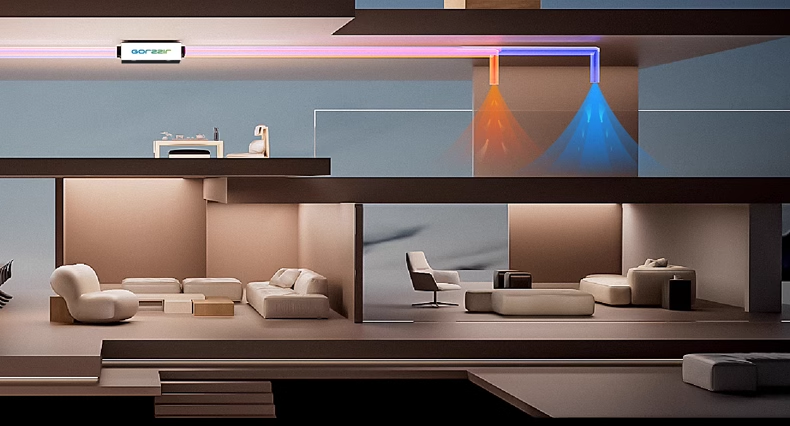Benefits of Combining Ventilating Dehumidifiers with Fresh Air Systems
Enhanced Indoor Air Quality
By integrating ventilating dehumidifiers with fresh air systems, I can significantly enhance indoor air quality. These systems work in tandem to lower humidity levels and introduce a steady flow of fresh outdoor air, improving the overall air environment inside buildings. Studies have demonstrated that maintaining optimal indoor air quality can reduce incidences of respiratory issues by up to 30%, offering substantial health benefits. Moreover, regularly replacing air filters and utilizing advanced filtration systems within these setups can effectively trap pollutants and allergens, ensuring a healthier indoor atmosphere.
Energy Efficiency Synergy
The combination of ventilating dehumidifiers with fresh air systems creates a synergy that enhances energy efficiency by reducing the load on HVAC systems. This leads to a noticeable reduction in energy consumption, making it a valuable investment for any facility. According to the U.S. Department of Energy, energy recovery ventilators can improve system efficiency by as much as 40-60%. By employing smart technology, these systems can detect ambient humidity levels and adjust their operations to further optimize energy usage, ensuring I get the most out of my energy expenditures.
Moisture Control and Structural Protection
Effective moisture control is essential for preventing mold growth and protecting structures from water damage. When I use combined systems, it's easier to maintain proper humidity levels, which is critical for mitigating these risks. Research indicates that managing humidity effectively can significantly reduce structural drying times by 30 to 50%, resulting in quicker restoration processes after any exposure to moisture. Additionally, a well-maintained ventilating dehumidifier extends the lifespan of building materials by preserving balanced moisture levels, safeguarding structural integrity and reducing maintenance costs over time.
How Ventilating Dehumidifiers Improve Airflow Optimization
Balancing Humidity and Ventilation
Ventilating dehumidifiers play a crucial role in balancing humidity and ventilation, essential for optimizing airflow in building environments. By maintaining the recommended humidity levels of 30-50% as suggested by the National Indoor Air Quality Standards, these systems prevent issues such as stagnant air and high energy costs. When humidity levels are either too high or too low, it can disrupt airflow dynamics, affecting both comfort and energy efficiency.
Integration with Existing HVAC Systems
Ventilating dehumidifiers offer seamless integration with existing HVAC systems, enabling property owners to enhance airflow without extensive modifications. Retrofitting these systems can lead to a 20-30% overall improvement in efficiency, as they optimize airflow and reduce strain on existing HVAC components. By collaborating with skilled HVAC technicians, we can ensure that installation complies with local codes and maintains system performance standards. This facilitates an upgrade path that preserves the longevity and efficiency of the HVAC infrastructure.
Smart Controls for Dynamic Adjustment
Smart controls in ventilating dehumidifiers enable real-time adjustments tailored to occupancy and humidity levels, enhancing airflow optimization. With smart ventilation systems, recent data indicates up to a 40% reduction in energy costs compared to traditional systems. Additionally, these smart controls can forecast maintenance needs, minimizing downtime and extending the lifespan of the system. By leveraging technology, these systems create a dynamically adjusted environment that adapts efficiently to varying demands.
Fresh Air Systems: Core Components for Healthy Air Circulation
Energy Recovery Ventilators (ERVs) Explained
Energy Recovery Ventilators (ERVs) play a crucial role in optimizing fresh air systems by minimizing energy losses during air exchange processes. ERVs can reclaim up to 80% of energy from exhausted air, significantly lowering the need for additional heating or cooling. This makes ERVs an efficient choice, especially in environments dealing with drastic temperature variations. By ensuring energy conservation and stable indoor environments, ERVs are indispensable for those aiming to enhance air circulation and comfort sustainably.
Filtration Mechanisms in Modern Systems
Modern fresh air systems incorporate advanced filtration mechanisms that are vital for maintaining superior air quality. Systems equipped with HEPA filters are particularly effective; they can capture particles as small as 0.3 microns and reduce allergens and pollutants by over 99%. Regular maintenance, including timely replacement of filters, is critical to keeping these systems functioning optimally. Consistent upkeep prevents the build-up of allergens and ensures the system's ability to maintain a high level of air cleanliness.
Zoning Strategies for Targeted Ventilation
Implementing zoning strategies in fresh air systems facilitates targeted ventilation, ensuring that specific areas receive the necessary airflow. By focusing on the differentiated needs of each zone, such strategies can enhance comfort and reduce energy expenses by up to 21% in larger buildings. Effective zoning relies on intelligent controls that adapt to the room's usage and occupancy levels, making it possible to streamline air circulation while meeting varied environmental requirements.
Common Challenges in Airflow Optimization Projects
Addressing Pressure Imbalances
Pressure imbalances in a building can cause inefficient airflow, leading to excessive energy use and poor air quality. To tackle this, it is important to regularly monitor building pressure measurements to quickly identify and correct any imbalances. This proactive approach is essential in any airflow optimization project. According to ASHRAE guidelines, properly balancing building pressure can enhance overall airflow performance by as much as 25%.
Managing Extreme Humidity Variations
Extreme humidity levels pose significant challenges to both fresh air systems and ventilating dehumidifiers, requiring robust management protocols. In regions with high humidity, advanced systems must be designed to handle moisture effectively to prevent mold growth and associated health risks. Data from the Centers for Disease Control and Prevention (CDC) indicates that about 50% of indoor air quality issues are related to fluctuations in humidity levels. Therefore, maintaining stable humidity is crucial for optimal indoor air quality.
Retrofitting Older Buildings
Retrofitting older buildings often presents unique challenges for airflow optimization, primarily due to outdated infrastructure. However, cost-effective retrofitting strategies can be developed to enhance airflow without compromising the building's structural integrity. Consulting with professionals who specialize in building performance can help navigate the complexities involved in these projects, ensuring that airflow challenges are effectively addressed while maintaining the building's unique characteristics.


 EN
EN












